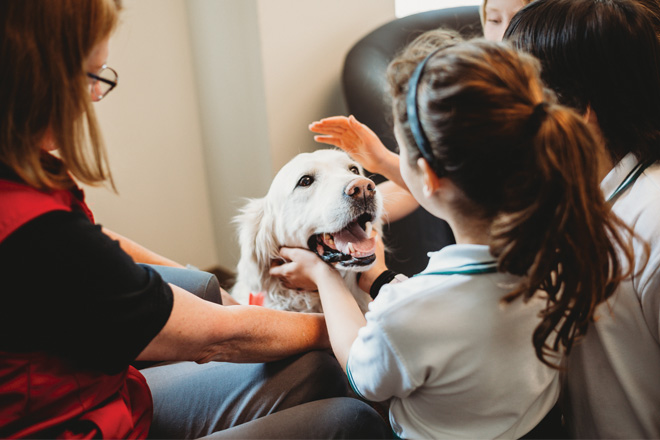|
Article by Tanja Mackin, Elmwood School
Feature image: Mackin with her therapy dog, Riley, and Elmwood students
I have been a volunteer with Ottawa Therapy Dogs for 15 years. In 2004, I saw the program’s brochure and was inspired by the idea of volunteering in a capacity very different from finance and operations. I enrolled in the training program with my dog at the time, a Shetland Sheepdog named Buddy, who had a sweet and gentle disposition. The training involves basic obedience, practice being around large groups of people and comfort around loud noises. Buddy passed the test, and I have been volunteering as a therapy dog handler ever since.
After Buddy retired, I bought Riley at eight-weeks-old and immediately started to groom him to become a therapy dog. This past year, I wanted to introduce Riley to Elmwood School because I had learned about successful therapy dog programs at colleges and universities. The purpose of Elmwood’s program is to help boost student health and wellness through small group visits, especially during exam period, when students tend to experience increased stress levels.
When designing the program, it was critical to locate a meeting room that was big enough for five to six students to interact with Riley at once, and also private, so that students who may be allergic or do not want to interact with dogs don’t see Riley.
With the support of the head of school, I kickstarted the program by introducing Riley to students during an assembly. I also wanted to confirm that Riley would be comfortable in a large room with lots of excited people. He did a great job, and the students were enthusiastic about having him at Elmwood.
Now I take Riley to campus to visit students once a week for about one hour in the morning and one in the afternoon. In between these sessions, Riley is in my office, where staff can visit and benefit from a little Riley therapy as well.
When designing the program, it was critical to locate a meeting room that was big enough for five to six students to interact with Riley at once, and also private, so that students who may be allergic or do not want to interact with dogs don’t see Riley. The biggest challenge of the program is making sure that the visiting groups are no larger than five to six students at a time. This helps Riley’s stress levels and provides a better student experience when each visitor can pet and interact with him.
Visiting with a therapy dog completely changes students' mood and mindset.
Overall, the reception from students, faculty and staff has been overwhelmingly positive. Most students’ favorite part is getting to pet and snuggle him while they ask a lot of questions. I try to make each visit a learning experience. I’ve also noticed that the program provides a safe environment for students who may have limited or no prior interaction with dogs. They can ask questions and develop a comfort level with dogs that they may have not had otherwise. But the most fulfilling part of the program is getting to see the smiles, giggles and excitement among the students. Visiting with a therapy dog completely changes their mood and mindset. Training and handling therapy dogs has been a wonderful outlet for me, but it is even more rewarding to share this opportunity with the students, faculty and staff at Elmwood School.
Over the summer I worked with a summer camp program for students interested in veterinary medicine, where they learn about dog care and basic training techniques. I am also incredibly grateful for the opportunity to visit with Riley at retirement and group homes. It’s rewarding to bring joy to people who may not have many visitors, and Riley is happy to be around people too.
While I had originally sought an outlet quite different from my job, I have found ways to merge my volunteer life and CPA background by serving as Ottawa Therapy Dogs’ bookkeeper and board treasurer for seven of my 15 years. Having brought finance knowledge to my therapy dog work, and my therapy dog to the school where I direct finance, I can says sometimes it’s better when worlds collide.



